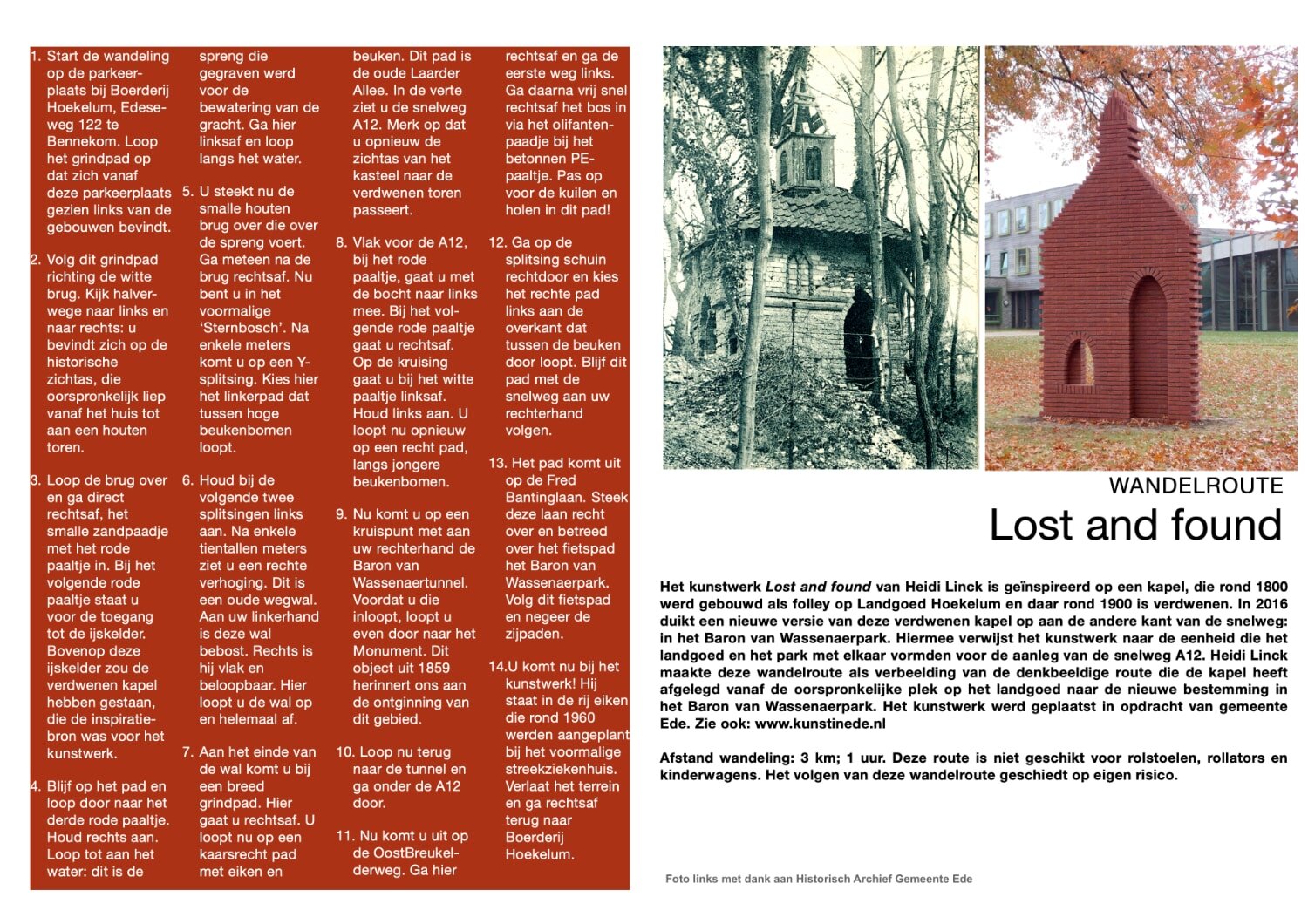Lost and found
2016
Baron van Wassenaerpark, Bennekom
Het Baron van Wassenaerpark in Bennekom is vernoemd naar de eigenaar van deze grond vóór de Tweede Wereldoorlog. Toen de Duitsers dwars door zijn landschapstuinen de snelweg A12 aanlegden, besloot de baron het gedeelte aan deze kant van de snelweg over te dragen aan de lokale gemeenschap, op voorwaarde dat de grond voor altijd zorgvoorzieningen zou huisvesten. Kort daarna werd daar het streekziekenhuis gebouwd en later ook andere zorginstellingen. Zo is dit voormalige deel van het landgoed getransformeerd van een historische landschapstuin naar een gebied vol zorgarchitectuur.
Om de verbinding met het landgoed te herstellen, heb ik onderzoek gedaan in de archieven van het landgoed, waarbij ik een oude foto tegenkwam van een kapelachtige folly. Deze folly stond op het landgoed aan de andere kant van de snelweg en verdween rond 1900. Op de plek waar het moet hebben gestaan, vond ik resten van het dak en de bakstenen. Deze vondst was aanleiding om de verdwenen kapel- folly aan de overkant van de snelweg, in het Baron van Wassenaerpark, weer terug te laten komen in een nieuwe vorm die geïnspireerd is op de oorspronkelijke vorm. Ik plaatste de folly op een plek waar een van de eikenbomen, die tot de plantage bij het ziekenhuis behoorde, ook verdwenen was. Deze eiken behoren tot een soort die in de herfst helemaal rood kleurt. De bijbehorende wandelroute, die is uitgedeeld onder omwonenden, volgt de route die de folly van de oude naar de nieuwe locatie heeft afgelegd en komt langs plekken die verhalen over het landgoed dragen.
The Baron van Wassenaerpark in Bennekom is named after the owner of this land before the Second World War. When the Germans built the A12 highway right through his landscaped gardens, the baron decided to transfer the part on this side of the highway to the local community, on condition that the land would forever house healthcare facilities. Shortly afterwards, the regional hospital was built there and later other healthcare institutions. In this way, this former part of the estate has been transformed from a historic landscaped garden into an area full of healthcare architecture.
In order to reconnect both parts of the estate, I did research in archives, during which I came across an old photo of a chapel-like folly. This folly stood on the estate on the other side of the highway and disappeared around 1900. At the place where it must have stood, I found remains of the roof and the bricks. This discovery was the reason to bring back the disappeared chapel folly on the other side of the highway, in the Baron van Wassenaerpark, in a new form that is inspired by the original form. I placed the folly in a place where one of the oak trees, which belonged to the plantation at the hospital, had also disappeared. These oaks belong to a species that turns completely red in the fall. The accompanying walking route, which was distributed among local residents, follows the route that the folly took from the old to the new location and passes places that carry stories about the estate.
Lost and found
2016
Folley + walking trail
Red brick, concrete, steel
210 x 40 x 432 cm
Design byr Heidi Linck
Production and installation in collaboration with Bouwbedrijf Van Grootheest, Ede
Commissioned by Gemeente Ede
Supported by Mondriaan Fonds





